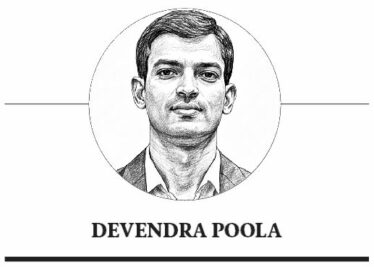Opinion: Bihar and Beyond — The feminisation of welfare politics
By turning welfare into a transactional exchange rather than a rights-based entitlement, political parties risk reducing women’s citizenship to consumer choice

By Devendra Poola
One of the most closely watched elements in the Bihar Assembly election was the direct courting of women voters through large-scale cash transfers. This approach was demonstrated just weeks before the polls on October 3, 2025, when Bihar Chief Minister Nitish Kumar transferred Rs 2,500 crore to the bank accounts of 25 lakh women under the Mukhyamantri Mahila Rojgar Yojana.
Also Read
In Bihar, as in several other States, women have emerged as the fulcrum of electoral politics. Their growing turnout, decisive voting behaviour, and perceived moral legitimacy as welfare recipients have made them a central constituency around which parties are designing new political narratives. The Mukhyamantri Mahila Rojgar Yojana is thus not just an economic intervention; it is a strategic tool that fuses welfare with political persuasion.
Potent Electoral Currency
Bihar’s political landscape over the past decade reflects a clear feminisation of welfare politics. Nitish Kumar’s earlier initiatives, ranging from distributing bicycles to schoolgirls to promoting self-help groups through Jeevika, built a reputation for gender-sensitive governance. Yet, what distinguishes the current moment is the convergence between welfare delivery and electoral calculus.
Not just the JD(U), but the Mahagathbandhan (RJD and Congress) had also announced the Mai Bahin Samman Yojana, promising monthly financial assistance of Rs 2,500 to women from backwards and economically vulnerable communities. The Jan Suraaj Party, led by Prashant Kishor, pledged to allocate 40 of its 243 Assembly seats to women candidates.
This phenomenon is not isolated. Across India, cash transfers to women have become the most potent electoral currency. From the Gruha Lakshmi scheme in Karnataka to Ladli Behna in Madhya Pradesh, and from Lakshmir Bhandar in West Bengal to Kalaignar Magalir Urimai Thittam in Tamil Nadu, nearly every State has institutionalised some form of women-centric direct benefit transfer (DBT) programme. A 2025 policy brief by Professor Prabha Kotiswaran of King’s College London estimates that across 11 States, 113 million women currently receive payments ranging from Rs 1,000 to Rs 2,500 per month, with five more States set to launch similar schemes.
Gendered Realignment
Empirical data across elections shows women’s participation has surpassed men’s in several States, redefining the very logic of political mobilisation. For example, in Bihar, women’s turnout has consistently outpaced men’s since 2005 — 60.48 per cent versus 53.32 per cent in 2015, and 59.7 per cent versus 54.7 per cent in 2020. The same pattern holds in Lok Sabha elections — women accounted for 59.45 per cent of voters in 2024 compared to 53 per cent of men. This inversion of turnout patterns has recalibrated electoral strategy. Parties now view women not merely as dependents of male voters but as autonomous political agents whose preferences can decisively swing outcomes.
These schemes do not necessarily expand women’s structural agency in labour markets or political institutions; rather, they stabilise electoral loyalties
Political scientists have termed this shift the “gendered realignment of the electorate”, where women’s voting behaviour is more stable, programmatic, and welfare-responsive in contrast with the often volatile and caste-anchored male vote. This is why parties across the ideological spectrum are converging on the same instrument: unconditional or quasi-conditional cash transfers targeted at women.
Direct cash transfers to women also reconfigure household power dynamics. By placing money directly in women’s hands, governments claim to promote financial autonomy. Yet, this autonomy is politically mediated. It transforms the state into a personal benefactor, embedding gratitude and loyalty within domestic and moral economies. As scholars like Kanchan Chandra and Partha Chatterjee have noted, welfare in India is not just distributive; it is relational, performed through the idiom of care and dependence.
DBTs thus function as instruments of state feminisation, in which women are constructed as the ideal moral subjects of welfare — responsible, non-disruptive, and apolitical. Political parties exploit this moral imagery, framing women not as rights-bearing citizens but as grateful recipients of state largesse. This produces a new clientelist compact in which cash is exchanged for compliance and continued support. Women voters embody moral legitimacy in the public imagination.
When welfare is routed through women, it acquires a symbolic purity that masculine patronage politics lacks. Nitish Kumar, Mamata Banerjee, and Stalin have all framed their welfare schemes in maternal idioms — ladli, maiya, behna, magalir. These linguistic choices are not incidental. They feminise the state, positioning the leader as a benevolent patriarch or maternal guardian. This moralisation of welfare is politically powerful because it sidesteps ideological divides. Even Prime Minister Narendra Modi, who once derided welfare transfers as revdi (freebies), has since embraced gendered welfare optics through schemes like Ujjwala and Lakhpati Didi. The revdi critique has given way to competitive populism, where moral worth is attached to women’s welfare spending.
The shift to DBT has redefined how welfare is experienced and remembered. By directly crediting money into women’s accounts, governments eliminate bureaucratic intermediaries, allowing beneficiaries to associate the benefit with the leader personally. The technological mediation of welfare through Jan Dhan, Aadhaar, and mobile connectivity transforms welfare into a personalised digital contract between the leader and the beneficiary.
For instance, the Nitish Kumar government’s announcement of Rs 2,500 crore was accompanied by SMS notifications and digital dashboards, ensuring beneficiaries could directly attribute the benefit to the Chief Minister. This personalisation of welfare delivery has electoral consequences: it transforms women, voters into “digitally traceable citizens”, whose gratitude can be mobilised at the ballot box.
The political returns of women-centric welfare are now empirically evident. In Karnataka (2023), Congress’s Gruha Lakshmi and free bus ride promises significantly boosted its performance among women voters. A similar pattern was visible in Himachal Pradesh (2022). In West Bengal (2021), Mamata Banerjee’s Lakshmir Bhandar scheme helped blunt anti-incumbency by reinforcing her personal connection with women voters.
From Empowerment to Instrumentalisation
While these schemes are often presented as emancipatory, their deeper logic is instrumental. They do not necessarily expand women’s structural agency in labour markets or political institutions; rather, they stabilise electoral loyalties. The scale and speed of these cash transfers suggest not a rights-based welfare paradigm but an electoral welfare regime, where short-term financial relief substitutes for systemic empowerment.
The conceptual problem here lies in the depoliticisation of welfare. By transforming welfare into a transactional exchange rather than a redistributive entitlement, political parties risk reducing women’s citizenship to consumer choice. The message is clear: empowerment comes not through collective mobilisation or policy reform, but through the benevolence of leaders. This dynamic echoes “biopolitical governance,” where welfare becomes a means to govern populations through care rather than rights. Women, as the moral core of the household, become the entry point for the state to penetrate everyday life, regulating consumption, loyalty, and gratitude simultaneously.
Overall, feminised populism cuts across ideology, geography, and party identity. What distinguishes it from earlier populisms is its directness, digitality, and demographic precision. In this new paradigm, political competition is not about whether to provide welfare, but how to target, brand, and narrate it. Yet, the long-term question remains: can this model sustain democratic accountability? As parties compete in outbidding each other through DBTs, welfare risks becoming de-linked from structural reform in employment, healthcare, or education areas that could genuinely transform women’s lives.

(The author is Senior Research Fellow, Centre for Economic and Social Studies [CESS], Hyderabad)
Related News
-
Anantjeet, Darshna win mixed team gold at National Shooting
3 hours ago -
Atanu, Anandrao win individual titles for men and women in Senior National archery championship
3 hours ago -
Rakesh’s double ton propels St Mark’s to massive win at HCA Inter-schools
4 hours ago -
No electricity dues pending, says GITAM University Hyderabad
4 hours ago -
Sports briefs: Diya, Aabha win girls doubles sub-junior national badminton U-13 final
4 hours ago -
Gram panchayat polls pointer to growing public discontent against Congress, says BRS
4 hours ago -
AITUC alleges political interference in SCCL, warns of mass stir to protect Singareni
4 hours ago -
Former hockey coach Doraiswamy no more
4 hours ago




